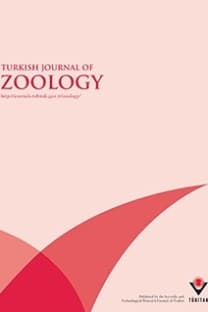Effect of land cover on biodiversity and composition of a soil macrofauna community in a reclaimed coastal area at Yancheng, China
Key words: Reclamation, coastal ecosystem, soil evolution, soil macrofauna, wetlands
Effect of land cover on biodiversity and composition of a soil macrofauna community in a reclaimed coastal area at Yancheng, China
Key words: Reclamation, coastal ecosystem, soil evolution, soil macrofauna, wetlands,
___
- An S, Li H, Guan B, Zhou C, Wang Z, Deng Z, Zhi Y, Liu Y, Xu C, Fang S et al. (2007). China’s natural wetlands: past problems, current status, and future challenges. Ambio 36: 335–342.
- Azul AM, Mendes SM, Sousa JP, Freitas H (2011). Fungal fruitbodies and soil macrofauna as indicators of land use practices on soil biodiversity in Montado. Agroforest Syst 82: 121–138.
- Barbier S, Gosselin F, Balandier P (2008). Influence of tree species on understory vegetation diversity and mechanisms involved—a critical review for temperate and boreal forests. Forest Ecol Manag 254: 1–15.
- Barrios E, Cobo JG, Rao IM, Thomas RJ, Amezquita E, Jimenez JJ, Rondon MA (2005). Fallow management for soil fertility recovery in tropical Andean agroecosystems in Colombia. Agr Ecosyst Environ 110: 29–42.
- Barros E, Pashanasi B, Constantino R, Lavelle P (2002). Effects of land-use system on the soil macrofauna in western Brazilian Amazonia. Biol Fert Soils 35: 338–347.
- Dewan AM, Yamaguchi Y (2009a). Land use and land cover change in Greater Dhaka, Bangladesh: using remote sensing to promote sustainable urbanization. Appl Geogr 29: 390–401.
- Dewan AM, Yamaguchi Y (2009b). Using remote sensing and GIS to detect and monitor land use and land cover change in Dhaka Metropolitan of Bangladesh during 1960-2005. Environmental Monitoring and Assessment 150: 237–249.
- Dewan AM, Yamaguchi Y, Rahman MZ (2012). Dynamics of land use/cover changes and the analysis of landscape fragmentation in Dhaka Metropoltian, Bangladesh. GeoJoornal 77: 315–330.
- Drummond MA, Loveland TR (2010). Land-use pressure and a transition to forest-cover loss in the eastern United States. Bioscience 60: 286–298.
- Duke NC, Meynecke JO, Dittmann S, Ellison AM, Anger K, Berger U, Cannicci S, Diele K, Ewel KC, Field CD et al. (2007). A world without mangroves? Science 317: 41–42.
- Etter A, McAlpine C, Pullar D, Possingham H (2006). Modelling the conversion of Colombian lowland ecosystems since 1940: Drivers, patterns and rates. J Environ Manage 79: 74–87.
- Fernández S, Santín C, Marquínez J, Álvarez MA (2010). Saltmarsh soil evolution after land reclamation in Atlantic estuaries (Bay of Biscay, North coast of Spain). Geomorphology 114: 497–507.
- Ge BM, Li ZX, Zhang DZ, Zhang HB, Liu ZT, Zhou CL, Tang BP (2012). Communities of soil macrofauna in green spaces of an urbanizing city at east China. Rev Chil Hist Nat 85: 219–226.
- Hammer Ø, Harper DAT, Ryan PD (2001). PAST: Paleoontological statistical software package for education and data analysis. Palaeontol Electron 4: 1–9.
- Huston MA (2005). The three phases of land-use change: implications for biodiversity. Ecol Appl 15: 1864–1878.
- Margalef DR (1957). Information theory in ecology. Gen Syst 3: 36–
- Martínez ML, Pérez-Maqueo O, Vázquez G, Castillo-Campos G, García-Franco J, Mehltreter K, Landgrave R (2009). Effects of land use change on biodiversity and ecosystem services in tropical montane cloud forests of Mexico. Forest Ecol Manag 258: 1856–1863.
- Mora C, Sale PF (2011). Ongoing global biodiversity loss and the need to move beyond protected areas: a review of the technical and practical shortcomings of protected areas on land and sea. Mar Ecol Prog Ser 434: 251–266.
- Paoletti MG, D’incà A, Tonin E, Tonon S, Migliorini C, Petruzzelli G, Pezzarossa B, Gomiero T, Sommaggio D (2009). Soil invertebrates as bio-indicators in a natural area converted from agricultural use: the case study of Vallevecchia-Lugugnana in north-eastern Italy. J Sustain Agr 34: 38–56.
- Paterson DM, Hanley M, Black K, Defew EC, Solan M (2011). Science and policy mismatch in coastal zone ecosystem management. Mar Ecol Prog Ser 434: 201–202.
- Pauli N, Barrios E, Conacher AJ, Oberthür T (2011). Soil macrofauna in agricultural landscapes dominated by the quesungual lashand-mulch agroforestry system, western Honduras. Appl Soil Ecol 47: 119–132.
- Reidsma P, Tekelenburg T, Van den Berg M, Alkemade R (2006). Impacts of land-use change on biodiversity: an assessment of agricultural biodiversity in the European Union. Agr Ecosyst Environ 114: 86–102.
- Schöll K, Devetter M (2013). Soil rotifers new to Hungary from the Gemenc floodplain (Duna-Dráva National Park, Hungary). Turk J Zool 37: 406–412.
- Shannon CE, Weaver W (1949). The Mathematical Theory of Communication. Urbana, Illinois: University of Illinois Press.
- Smith J, Chapman A, Eggleton P (2006). Baseline biodiversity surveys of the soil macrofauna of London’s green spaces. Urban Ecosystems 9: 337–349.
- Tasser E, Tappeiner U (2002). Impact of land use changes on mountain vegetation. Appl Veg Sci 5: 173–184.
- Wang J, Chen Y, Shao X, Zhang Y, Cao Y (2012). Land-use changes and policy dimension driving forces in China: present, trend and future. Land Use Policy 29: 737–749.
- Wolanski E (2007). Estuarine Ecohydrology. Elsevier: Amsterdam, the Netherlands.
- Wu J, Fu C, Lu F, Chen J (2005). Changes in free-living nematode community structure in relation to progressive land reclamation at an intertidal marsh. Appl Soil Ecol 29: 47–58.
- ISSN: 1300-0179
- Yayın Aralığı: 6
- Yayıncı: TÜBİTAK
Michal POLAKOWSKI, Monika BRONISZEWSKA, İreneusz RUCZYNSKI
Teoman KANKILIÇ, Tolga KANKILIÇ, Perinçek Seçkin Ozan ŞEKER, Erkut KIVANÇ
Baoming GE, Daizhen ZHANG, Boping TANG, Chunlin ZHOU
Sophia METALLAOUI, Mohamed Chérif MAAZI, Menouar SAHEB, Moussa HOUHAMDI, Christophe BARBRAUD
Rumen ciliate fauna (Ciliophora, Protista) of Turkish domestic goats living in İzmir, Turkey
İlknur YILDIZ, Ali Muzaffer FEYZİOĞLU
Yüksel COŞKUN, Nursel Aşan BAYDEMİR, Alaettin KAYA, Ayşe Merve KARÖZ
Digenean and cestode parasites of teleost fish from the Eastern Black Sea Region
